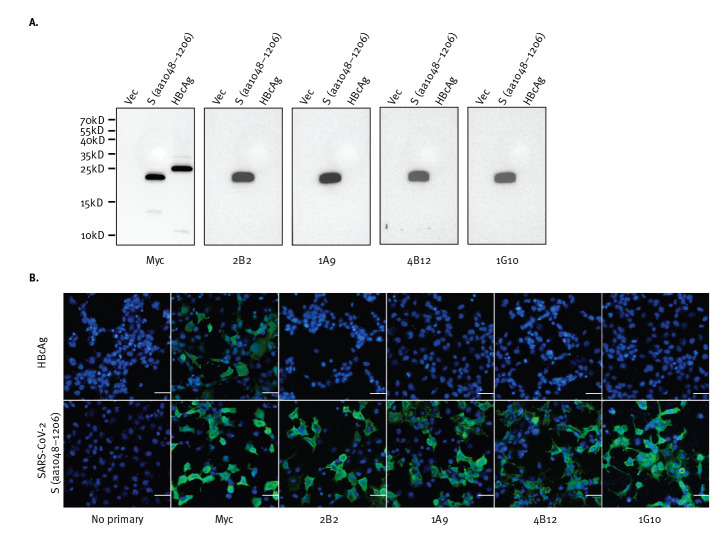Figure 2.
Monoclonal antibodies expected to target a SARS-CoV-2 S protein S2 fragment, (A) hybridise to the peptide fragment in western blot and (B) recognise cells expressing the peptide as shown by immunofluorescence
aa: amino acid; HBcAg: hepatitis B virus core antigen; DAPI: 4′,6-diamidino-2-phenylindole; SARS-CoV-2: severe acute respiratory syndrome coronavirus 2; S protein: spike protein; vec: pXJ40-Myc expression vector used as an empty vector control.
A. Each photo depicts a western blot using the primary antibody indicated below it (Myc, 2B2, 1A9, 4B12, or 1G10). Empty vector-transfected 293FT cell products are on the lanes labelled as ‘Vec’, while products of 293FT cells expressing Myc-tagged SARS-CoV-2 S protein fragment (aa 1048–1206; SARS-CoV-2 numbering) or Myc-tagged HBcAg are on the lanes respectively labelled ‘S’ or ‘HBcAg’. Primary antibodies were labelled with horseradish peroxidase-conjugated secondary antibodies. A ladder indicative of the molecular weights in kD of the proteins relative to their vertical position on the blots, is indicated on the left of the panel.
B. Each photo depicts an immunofluorescence assay using either no primary antibody, or the primary antibody indicated below it (Myc, 2B2, 1A9, 4B12, or 1G10). Immunofluorescence assay results of COS7 cells expressing Myc-tagged HBcAg (top photos) or a Myc-tagged fragment (aa1048–1206) of SARS-CoV-2 S protein (bottom photos) using the indicated primary antibodies, followed by Alexa Fluor 488-conjugated secondary antibody (green) are shown. Cell nuclei were counterstained with DAPI (blue). Scale bar = 50 µm.

